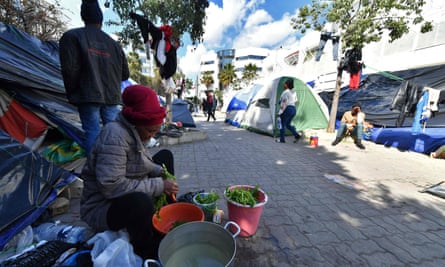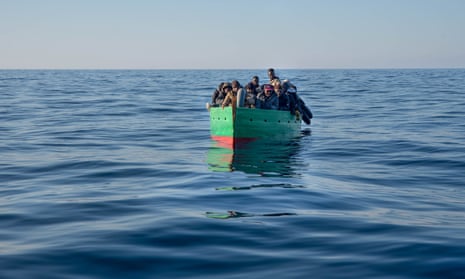On a recent afternoon in the Tunisian coastal city of Sfax, as shoppers hurried around a market buying food and drink for that evening’s iftar meal, a small group of men from sub-Saharan Africa gathered near a stall selling phone accessories.
One of them, Joseph, had made a two-week journey to the city from Cameroon eight months ago. His plan, like thousands before him fleeing poverty and conflict in Africa and the Middle East in the hope of a better life, had been to board a boat from near Sfax and cross the Mediterranean to Europe.
Now, reluctantly, he had changed his mind. The boat journey was too fraught with risk, and conditions in Tunisia had become intolerable. He was making plans to return to Cameroon.
“Look,” Joseph said, pointing to a photo on his phone of an acquaintance who had recently set off from Sfax. “He is now dead. He drowned.” Joseph alleged that when the Tunisian coastguard came across the boat, they removed its engine and left it at sea, where it sank.
Attempts to cross the sea from the coast around Sfax have increased sharply in recent weeks amid a wave of racist violence sparked by an incendiary speech by the Tunisian president, Kais Saied, who claimed that irregular migration from other parts of Africa was part of an international conspiracy to change Tunisia’s demographic character.
Families have reported being chased from their homes and even attacked with knives. Many have lost their precarious informal jobs, which pay for their food and rent, because their Tunisian employers fear arrest. In the capital, Tunis, growing numbers are sleeping under tarpaulins outside the offices of the UN refugee agency.
In the past week alone, 29 people from sub-Saharan African are known to have drowned after two boats sank off the coast of Sfax. On Wednesday, the regional director for health told the TAP news agency that the number of bodies of migrants in the local morgue had exceeded its capacity.
Standing near Joseph, carrying a bag of taboon flatbreads, was Olivier, from Ivory Coast. He arrived a year ago and has been trying to save the 3,000 dinars (£780) he said it would cost to make the trip to Europe.

“You need to have two jobs to pay for the crossing,” he said. “The money you earn from working is very little, sometimes just 20 dinars a day, which is not enough to live on.”
Olivier said it took most people two years to save enough to pay the smugglers. The smugglers charge less for crossings over winter, when the sea is rougher, which helps explain why the fatality rate for crossings by people from the sub-Sahara is much higher than for Tunisians, who are more likely to be able to afford to pay extra to cross in summer.
Asked about the dangers, he smiled. “If you have a dream in your mind, you will go,” he said. “Nothing will stop you.”
Olivier explained how it works: smugglers contact people hoping to cross and tell them to take taxis to points on the beaches along the coast. Once there, people can either attempt the crossing with a fisher, or buy a boat and pay extra for training in navigation.
According to UN data, at least 12,000 migrants who reached Italy this year set sail from Tunisia, compared with 1,300 in the same period of 2022. Previously, Libya was the main departure point.
Tunisia’s Forum for Social and Economic Rights said last week that the Tunisian coastguard prevented more than 14,000 people setting off in small boats during the first three months of this year, compared with 2,900 in the same period last year.
Saied has become increasingly autocratic since winning the presidency in 2019, stripping parliament of its powers and more recently overseeing the repression of political opponents and the free press.
His crackdown on undocumented migrants has been widely interpreted as an attempt to deflect blame for Tunisia’s economic woes.
Tunisians have themselves been leaving the country in ever greater numbers in recent years, and its economic future appears to rest on an IMF bailout that has been delayed by demands by the US and others for far-reaching reforms.
Last week, the Italian foreign minister, Antonio Tajani, conjured an image of “hundreds of thousands of people in the Mediterranean Sea” unless Tunisia’s financial collapse could be avoided.
In Sfax, Olivier gestured at a small, ad hoc marketplace staffed by undocumented people. “There are thousands of us in Tunisia,” he said. “It’s the migration capital of the Mediterranean.”
